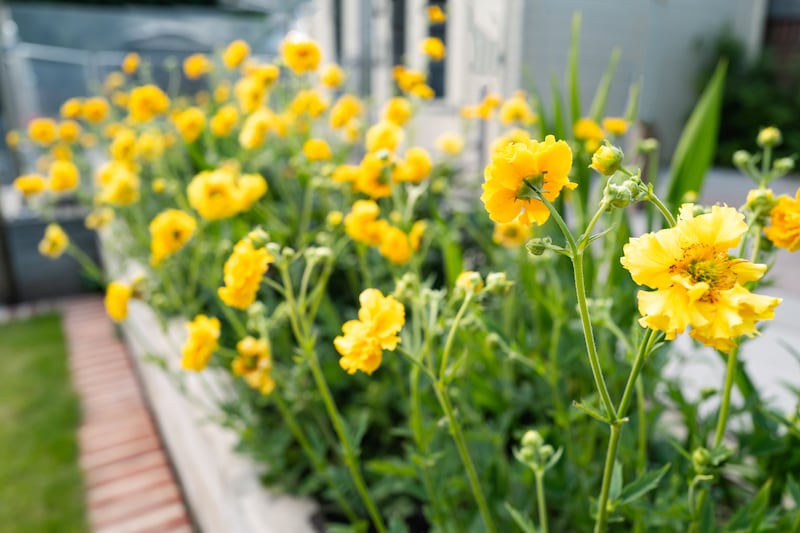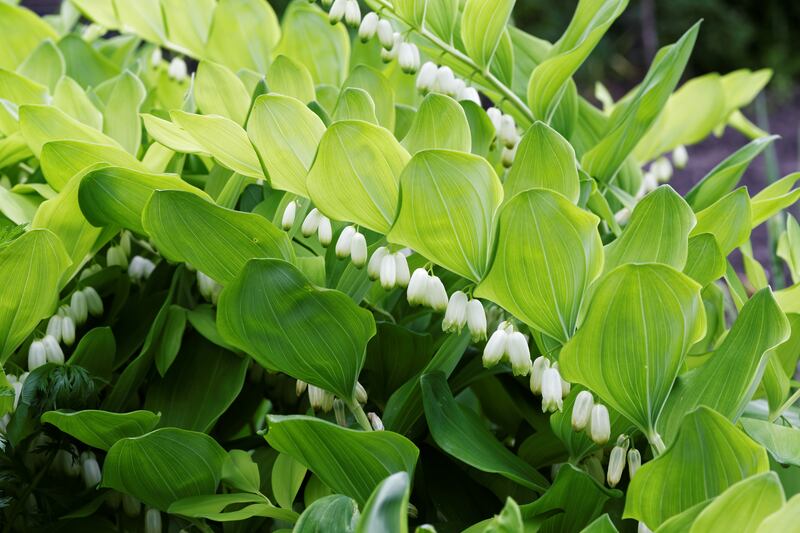For as long as I can remember I’ve loved picking flowers from the garden. Those earliest childhood bouquets were fat tangles of nasturtiums and buttercups, stuffed into jam jars, milk jugs filled with wild roses, vases of plump lupins. But for the past decade I’ve been growing cut-flowers for my work as a flower-farmer-florist, for which I’m always on the hunt for the most productive, floriferous, long-flowering, vigorous, versatile kinds best suited to the Irish climate.
Again and again I come back to perennials because they’re far less work, less faff and less wasteful of so many precious resources (time, energy, water, compost) than their much shorter-lived, labour-intensive annual and biennial counterparts.
Their larger, deeper, well-established root systems also make perennials much more capable of withstanding the increasingly unpredictable fluctuations of our weather, from the dry, chilly, windy springs of recent years to extremes such as drought and flooding. Once established, they’re also easily and quickly propagated through division and cuttings, making them the kinds of plants that just keep on giving. As climate change accelerates, it’s exactly this sort of resilient planting that our gardens need to flourish.
So which species and varieties are the best for the summer flower border or cut-flower patch? Here’s a look at some of my enduring favourites.
A middle-class millennial at a Kneecap gig: am I just cosplaying at republicanism?
What should I do if my electric car breaks down?
Matt Williams: In cynical times, savour the new coaches who want to make the world a bit better
Political stupidity of Fianna Fáil four could see Ireland end up with a bottom-of-the-barrel job in Europe

1 Achillea millefoilium (yarrow)
Easy to grow, long-flowering and hugely productive as a cut flower. I wouldn’t be without this mat-forming, herbaceous perennial, which needs a free-draining, not-too-rich soil and a spot in full sun. Lots of excellent, garden-worthy varieties are available in garden centres at this time of year, from the orange-flowered A. ‘Terracotta’ and bright-yellow A. ‘Coronation Gold’ to the spice-red A. ’Paprika’. Alternatively, this quick-growing perennial is very easily raised from seed sown in spring or autumn. In particular, seek out the seed mixes known as Achillea ‘Colorado’ and Achillea ‘Summer Berries’, both of which give a fantastic range of different colours and are suitable for drying (seedaholic.com). Average height and spread of 60cm x 45cm.
2 Astrantia (masterwort)
An excellent, exceptionally long-lived, no-fuss perennial for a cool, damp, fertile soil with tall, slender stems of pin cushion-shaped blooms in shades of plum, silver-white and pink that appear in June-August. Astrantia is one of those must-have plants for the cut-flower patch or flower border. Slow and difficult to raise from seed, this hardy herbaceous perennial is best bought as a container-grown plant, while established clumps can be easily divided in spring or autumn. Tolerant of light shade, its starry flowers last several weeks in a vase and are suitable for drying. Outstanding varieties include the dark-plum A. ‘Gill Richardson’, silver-pink ‘Buckland’, jewel-red A. ‘Ruby Wedding’ and the Sparkling Stars series. Average height and spread of 60-75cm.
3 Verbascum (mullein)
My latest love — exceptionally easy to raise from seed and invaluable for filling that tricky May gap in the flower border or cut-flower patch. These fast-growing perennials start to bloom at the same time as foxgloves. If I could grow only one variety, it would be the incomparably beautiful Verbascum hybridum ‘Southern Charm’, whose tall slender flower spires come in smudgy shades of peach, apricot, gold and rose. But any of the varieties of Verbascum phoeniceum also make a very pretty cut-flower. Best (and cheaply) raised from seed sown in spring or autumn or by root cuttings in early spring, verbascums need full sun and a moist but free-draining, not overly fertile soil. Height and spread of 90cm x 30cm.
4 Alchemilla mollis (lady’s mantle)
Some gardeners are sniffy about this resilient, adaptable, oh-so-obliging, summer-flowering herbaceous perennial on account of its ubiquity and readiness to self-seed abundantly when it’s happy. But its weed-suppressing mounds of pleated, scalloped leaves make a brilliant addition to the garden, while its graceful sprays of lime-green flowers are a versatile filler in any arrangement and are also suitable for drying. Ultra-hardy and happy in almost any growing conditions, it will produce a second flush of blooms if its faded flowers are sheared back in late summer and plants are given a liquid feed of seaweed. Height and spread of 60cm.
5 Geum (avens)

Geum, let me count the ways I love thee … Few plants can equal this resilient, long-lived, late spring-summer blooming, fast-growing herbaceous perennial for its prolific flowering habit and ease of cultivation, while it’s also impressively resistant to damage from deer, rabbits and slugs. Thanks to the work of modern plant breeders, its slender-stemmed, buttercup-like flowers now come in the most delicious range of colours. Outstanding varieties include the pink-apricot flowering G. ‘Mai Tai’, the golden-peach, long- flowering G. ‘Pretticoats Peach’ and rose-pink G. ‘Cosmopolitan’. Geums like a fertile, moisture-retentive but free-draining soil enriched with manure in full sun or light shade. Average height and spread 60cm.
6 Astilbe (false goatsbeard)

Yet another long-lived, resilient herbaceous perennial that loves the cool, damp growing conditions found in so many Irish gardens. Astilbes are known for their distinctive feathery flower plumes, which rise from clumps of finely divided foliage from midsummer. Happy in sun or partial shade so long as it’s given a rich, moist or even boggy soil that doesn’t ever completely dry out in summer. Many different varieties are available in a wide range of flower colours and heights. Mid-height varieties suitable for a damp, lightly shaded flower border include the long-flowering powder-pink Astilbe ‘Venus’ and the white-flowering A. ‘Weisse Gloria’ and A. ‘Gladstone’.
7 Polygonatum x hybridum (Solomon’s Seal)

A tall, graceful, late-spring/early summer flowering woodlander, with slender arching stems from which clusters of tiny, green-tipped white, bell-shaped flowers dangle, this is a great choice for a cool, rich, moist but well-drained soil in full sun or light shade. Its equally elegant cousin, Polygonatum verticillatum (commonly known as whorled Solomon’s Seal), likes similar growing conditions and is also well-worth seeking out for its fine, bronze-flushed foliage and tall, graceful stems of dainty green flowers. Both are clump-forming, hardy herbaceous perennials that reach an average height of 120cm.
8. Sanguisorba (burnet)
Once something of a rarity, this airy, graceful genus of perennials is growing in popularity as Irish gardeners discover that they thrive in our cool, moist soils and are brilliant for adding a delicate layer of colour and texture to a summer flower border. One of the very best is S. ‘Red Thunder’, whose long-lasting, deep-red, bobble-shaped flowers appear on thin wiry stems from June to September. Happy in sun or light shade. This clump-forming hardy herbaceous perennial reaches an average height and spread of 100-120cm x 60-90cm.
This week in the garden
To keep plants healthy and floriferous, repeat-flowering roses should be regularly deadheaded and given a potash-rich organic liquid rose feed every 10-14 days, either as a drench to the soil around the root system or as a liquid foliar feed. Foliar feeds should be applied when the weather is dry and at a time of day when the plant isn’t in direct sunshine.
Listen out for blight warnings and keep a watchful eye out for signs of potato blight, which can start to strike plants at this time of year. Early indications of this damaging fungal disease include dark-brown patches surrounded by a pale “halo”, wilting foliage and stems. If blight does hit, act quickly by cutting the plant stems or caulms back down to ground level, bagging them and disposing of them by burning them or binning them carefully off-site.
Dates for your diary
Saturday, July 2nd-Sunday, July 3rd
Galway Garden Festival, Claregalway, Co Galway, with specialist plant sales, free garden design advice, an exhibition of botanic art, street theatre, artisan food stalls, children’s entertainment and a range of guest speakers including Bleddwyn Wynne Jones of Wales-based Crug Farm; botanic artist and author Janet Stark; Dr Phil Havercroft of Wicklow-based Leamore Nurseries; ecologist and naturalist Dr Cilian Roden; Finlay Colley of Dublin-based Rare Plants Ireland nursery; Sean Queally, Coillte environmental officer and project manager for Woodland Restoration Ireland; Dave Foley of Greenman Nurseries; and Fionnuala Fallon. galwaygardenfestival.com
Sunday, July 10th (10am-5pm)
Garden designer Arthur Shackleton and artist Carol Booth are hosting a garden open day at their home, Fruitlawn, Abbeyleix, Co Laois. arthurshackleton.com
Friday, July 29th-Saturday, July 30th
Maynooth University, Co Kildare. The 74th Annual FIBKA Beekeeping Summer School will take place with a wealth of talks, training sessions, practical workshops and demonstrations, trade stands and exhibits plus the Irish National Honey Show. irishbeekeeping.ie






